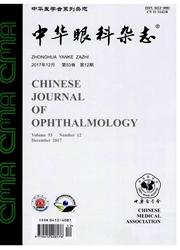

 中文摘要:
中文摘要:
目的 探讨小分子化合物J2在抑制小鼠角膜移植排斥反应中的作用。方法以23只C57BL/6小鼠作为供体,76只BALB/c小鼠作为受体建立角膜移植实验模型,随机数字法分为A、B、C及D组,A组为BALB/c小鼠自体原位角膜移植,B、C及D组为C57BL/6-BALB/c小鼠间同种异体角膜移植。术后灌胃给药,A组和B组给予不含药物的空白液,C组和D组分别给予环孢素A(CsA)和小分子化合物J2,连续灌胃12d,比较各组小鼠角膜植片的存活时间和存活率,术后21d对各组小鼠行外周血单核细胞行流式细胞学检查,并做角膜植片的组织学检查。结果A组观察期内角膜植片未发生排斥,B组角膜植片平均存活时间为(17.8±2.1)d,C组为(38.1±9.9)d,D组角膜植片存活时间为(40.6±8.3)d,D组与A组(P=0.04)及B组(P=0.00)比较存活时间差异均有统计学意义,与C组比较差异无统计学意义(P:0.99)。流式细胞学检查显示J2给药小鼠外周血CD^+细胞、CD8^+细胞未发生增殖,组织学检查证实术后21dD组角膜植片未见明显的淋巴细胞浸润。结论小分子化合物J2能够抑制排斥的发生,延长小鼠角膜植片存活时间。(中华胺群条峦,2007,43:608-612)
 英文摘要:
英文摘要:
Objective To investigate the effects of small non-peptidic CD4 inhibitor J2 on the prevention of allograft rejection in mouse corneal transplantation. Methods Twenty-three C57BL/6 mice (donor) and 76 BALB/c mice (recipients) were used to establish corneal allograft model, and were divided into 4 groups randomly. Group A, autograft control; Group B, allograft control ( placebo was given in both control groups) ; Group C and Group D, allograft groups, were treated with orally ciclosporin A and J2, respectively. Drugs were delivered for 12 days beginning on the day of transplantation. Graft survival was assessed by Kaplan-Meier analysis. On day 21 after transplantation, flow cytometry analysis of peripheral blood mononuclear cells and histological examination of graft were performed. Results No graft rejection was observed in Group A. The average transplant survival time of Group B was( 17. 8± 2. 1 )d. In Group D, the transplant survival time showed a statistically prolongation to (40. 6 ± 8.3 )d (P = 0.00 ) as compared with Group B, but the survival time was less than that of Group A (P = 0. 04 ). There was no statistically significant difference between Group D and Group C (38. 1 ± 9.9 )d (P = 0. 99 ). The results of flow cytometry analysis showed that CD4 ^+ cells and CD8^+ cells in peripheral blood mononuclear cells did not increase in Group D. Fewer inflammatory cells were found in the corneal allograft in Group D. Conclusion J2 could inhibit rejection and prolong corneal allograft survival time in mouse. (Chin J Opbtbalmol, 2007, 43:608-612 )
 同期刊论文项目
同期刊论文项目
 同项目期刊论文
同项目期刊论文
 期刊信息
期刊信息
